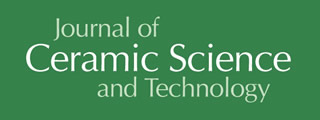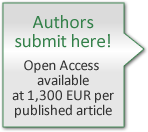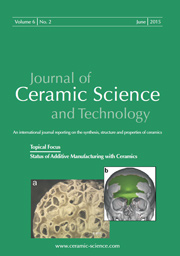Articles
All articles | Recent articles
Influence of Temperature Dependence of Bulk Modulus on Crack Propagation Velocity
D. Pilipenko, Y. Natanzon, H. Emmerich
Material and Process Simulation Group, University of Bayreuth Universitätsstrasse 30, 95447 Bayreuth, Germany
received October 21, 2013, received in revised form December 19, 2013, accepted January 22, 2014
Vol. 5, No. 2, Pages 77-82 DOI: 10.4416/JCST2013-00033
Abstract
Multiscale modeling of crack propagation in homogeneously heated aluminium oxide is presented. It is known that the crack propagation velocity depends on both the bulk modulus and surface energy of a material. The temperature dependence of surface energy is often ignored owing to the difficulty associated with obtaining a reliable measurement. Such dependence was calculated in atomic-scale calculations by means of Molecular Dynamics with MEAM potential. The dependence shows a linear decrease with an increase in temperature. The MD results are used as input for phase field simulations of fracture. It is shown that if only the temperature dependence of the bulk modulus is taken into account the crack velocity decreases by 30 %. However, only a 2 % decrease is observed when both the temperature dependence of surface energy and bulk modulus are considered.
![]() Download Full Article (PDF)
Download Full Article (PDF)
Keywords
Fracture mechanics, fatigue and cracks, high-temperature ceramics, computational methods in continuum mechanics, multiscale modeling
References
1 Adda-Bedia, M., Arias, R., Ben Amar, M., Lund, F.: Dynamic instability of brittle fracture, Phys. Rev. Lett., 82, (11), 2314 – 2317, (1999).
2 Adda-Bedia, M., Ben Amar, M.: Stability of quasiequilibrium cracks under uniaxial loading, Phys. Rev. Lett., 76, [9], 1497 – 1500, (1996).
3 Baskes, M.: Modified embedded atom potentials for cubic materials and interfaces, Phys. Rev. B, 46, 2727 – 2742, (1992).
4 Baskes, M.: Modified embedded atom method calculations of interfaces, Sandia, 96, 8484, (1996).
5 Brener, E.A., Spatschek, R.: Fast crack propagation by surface diffusion, Phys. Rev. E, 67, 016112, (2003).
6 Broberg, K.B.: Cracks and Fracture, Academic Press, (1999).
7 Daw, M., Baskes, M.I.: Embedded atom method: Derivation and application to impurities, surfaces, and other defects in metals, Phys. Rev. B, 29, 6443 – 6453, (1984).
8 Fleck, M., Pilipenko, D., Spatschek, R., Brener, E.A.: Brittle fracture in viscoelastic materials as a pattern-formation process, Phys. Rev. E, 83, 046213, (2011).
9 Freund, L.B.: Dynamic Fracture Mechanics, Cambridge University Press, (1998).
10 Griffith, A.A.: The phenomena of rupture and flow in solids, Phil. Trans. R. Soc. Lond., 221(582 – 593):163 – 198, (1921).
11 Gugenberger, C., Spatschek, R., Kassner, K.: Comparison of phase-field models for surface diffusion, Phys. Rev. E, 78, [1], 016703, (2008).
12 Heinz, H., Vaia, R.A., Farmer, B.L., Naik, R.R.: Accurate simulation of surfaces and interfaces of face-centered cubic metals using 12 – 6 and 9 – 6 lennard-jones potentials, J. Chem. Phys., 112, 17281, (2008).
13 Jen, S.-H., Bertrand, J.A., George, S.M.: Critical tensile and compressive strains for cracking of Al2O3 films grown by atomic layer deposition, J. App. Phys., 109, 084305, (2011).
14 Kassner, K., Misbah, C., Müller, J., Kappey, J., Kohlert, P.: Phase-field modeling of stress-induced instabilities, Phys. Rev. E, 63, 036117, (2001).
15 Kohn, K.: Nobel lecture: Electronic structure of matter—wave functions and density functionals, Rev. Mod. Phys., 71, 1253 – 1266, (1999).
16 Krell, A., Pippel, E., Woltersdorf, J., Burger, W.: Subcritical crack growth in Al2O3 with submicron grain size, J. Eur. Ceram. Soc., 23, 81, (2003).
17 Kuo, C.-L., Clancy, P.: Development of atomistic MEAM potentials for the silicon-oxygen-gold system, Model. Simul. Mater. Sci. Eng., 13, 1309 – 1329, (2005).
18 Luan, B., Robbins, M.O.: The breakdown of continuum models for mechanical contacts, Nature, 435, 929, (2005).
19 Mehl, M.J., Papaconstantopoulos, D.A.: Applications of a tight-binding total-energy method for transition and noble metals: Elastic constants, vacancies, and surfaces of monatomic metals, Phys. Rev. B, 54, 4519, (1996).
20 Mishin, A., Farkas, D., Mehl, M.J., Papaconstantopoulos, D.A.: Interatomic potentials for monoatomic metals from experimental data and ab initio calculations, Phys. Rev. B, 59, 3393 – 3407, (1999).
21 Munro, R.G.: Evaluated material properties for a sintered alpha alumina, J. Am. Ceram. Soc., 80, 1919 – 1928, (1997).
22 Natanzon, Y., Pilipenko, D., Emmerich, H.: Multiscale modeling of thermoshock in aluminium oxide ceramics, refractories WORLDFORUM, 1, 4, (2012).
23 Plimpton, S.J.: Fast parallel algorithms for short-range molecular dynamics, J. Comput. Phys., 117, 1 – 19, (1995).
24 Ramanathan, S., Fisher, D.S.: Dynamics and instabilities of planar tensile cracks in heterogeneous media, Phys. Rev. Lett., 79, [5], 877 – 880, (1997).
25 Riko, I.M., Pramana, S.S., Rong, E.P.J., Cheong, W.C., Zhong, C., Yoong, A.T.I., Lip, G.C.: Study of metal additives to alumina substrate for high temperature and pressure application, IEEE Electronics Packaging Technology Conference (EPTC), 14, 48, (2012).
26 Spatschek, R., Brener, E.A., Pilipenko, D.: Crack growth by surface diffusion in viscoelastic media, Phys. Rev. Lett., 101, [20], 205501, (2008).
27 Spatschek, R., Hartmann, M., Brener, E., Müller-Krumbhaar, H, Kassner, K.: Phase field modeling of fast crack propagation, Phys. Rev. Lett., 96, 015502, (2006).
28 Streitz, F.H., Mintmire, J.W.: Electrostatic potentials for metal-oxide surfaces and interfaces, Phys. Rev. B, 50, 11996 – 12003, (1994).
Copyright
Göller Verlag GmbH


